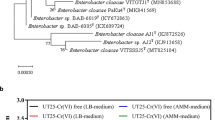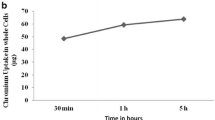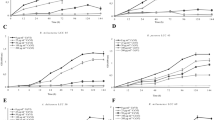Abstract
Bacterial strains ZA-6, W-61, KS-2 and KS-14 were isolated from agricultural soil irrigated with tannery effluents and subsequently identified by 16S rDNA sequencing as Stenotrophomonas maltophilia, Staphylococcus gallinarum, Pantoea sp. and Aeromonas sp., respectively. All isolates were examined for their resistance to hexavalent chromium and other heavy metal ions. The bacterial isolate S. maltophilia ZA-6 and S. gallinarum W-61 were resistant to 16.5 and 12.4 mM of potassium chromate, respectively, whereas Pantoea sp. KS-2 and Aeromonas sp. KS-14 were found to be sensitive to potassium chromate. S. maltophilia ZA-6 and S. gallinarum W-61 completely reduced 500 μM Cr6+ to Cr3+ within 56 h, while chromate-sensitive isolates Pantoea sp. KS-2 and Aeromonas sp. KS-14 exhibited poor chromate-reducing activity. Chromate reduction was severely affected in the presence of the metabolic inhibitors sodium cyanide and sodium azide. Sodium cyanide completely inhibited chromate reduction in each isolate, whereas 1 mM sodium azide and 10 mM sodium sulfate affected the inhibition of chromate reduction to varying degrees. The use of 1 mM 2,4-dinitrophenol, an uncoupling agent, stimulated the chromate reduction. The cell-free extract (CFE) of chromate-resistant isolates readily reduced Cr6+ to Cr3+, with that of S. gallinarum W-61 showing a Km value of 121.7 μM chromate and a Vmax of 1.12 μmol/min per milligram protein in the presence of NADH. The chromate-resistant isolates displayed lower Michealis–Menton constant (Km) values and higher maximum velocity (Vmax) than chromate-sensitive isolates. These results suggest that chromate resistance and reduction in these bacteria are related.


Similar content being viewed by others
References
Abou-Shanab RAI, van Berkum P, Angle JS (2007) Heavy metal resistance and genotypic analysis of metal resistance genes in gram-positive and gram-negative bacteria present in Ni-rich serpentine soil and in the rhizosphere of Alyssum murale. Chemosphere 68:360–367
Alam MZ, Malik A (2008) Chromate resistance, transport and bioreduction by Exiguobacterium sp. ZM-2 isolated from agricultural soil irrigated with tannery effluent. J Basic Microbiol 48:416–420
Aleem A, Isar J, Malik A (2003) Impact of long term application of industrial wastewater on the emergence of resistance traits in Azotobacter chroococcum isolated from rhizospheric soil. Biores Technol 86:7–13
Alvarez AH, Sanchez RM, Cervantes C (1999) Chromate efflux by means of the ChrA chromate resistance protein from Pseudomonas aeruginosa. J Bacteriol 181:7398–7400
Asatiani NV, Abuladze MK, Kartvelishvili TM, Bakradze NG, Spojnikova NA, Tsibakhashvili NY, Tabatadze LV, Lejava LV, Asanishvili LL, Holman HY (2004) Effect of chromium (VI) action on Arthrobacter oxydans. Curr Microbiol 49:321–326
Bae WC, Lee HK, Choe YC, Jahng DK, Lee SH, Kim SJ, Lee JH, Jeong BC (2005) Purification and characterization of NADPH dependent Cr(VI) reductase from Escherichia coli ATCC 33456. J Microbiol 43:21–27
Bartlett R, James BR (1979) Behavior of chromium in soils. III. Oxidation. J Environ Qual 8:31–34
Bopp LH, Ehrlich HL (1988) Chromate resistance and reduction in Pseudomonas fluorescens strains LB 300. Arch Microbiol 150:426–431
Camargo FAO, Okeke BC, Bento FM, Frankenberger WT (2003) In vitro reduction of hexavalent chromium in a cell-free extract of Bacillus sp. ES 29 stimulated by Cu2+. Appl Microbiol Biotechnol 62:569–573
Cappuccino JG, Sherman N (eds) (1995) Microbiology: A laboratory manual, 3rd edn. Pearson Education, London
Cervantes C, Campos-Garcia J, Devars S, Gutierrez-Corona F, Loza-Tavera H, Torres-Guzman JC, Moreno-Sanchez R (2001) Interactions of chromium with microorganisms and plants. FEMS Microbiol Rev 25:335–347
Cheung KH, Gu JD (2007) Mechanism of hexavalent chromium detoxification by microorganisms and bioremediation application potential: a review. Int Biodeterior Biodegrad 59:8–15
Cordoba A, Vargas P, Dussan J (2008) Chromate reduction by Arthrobacter CR47 in biofilm packed bed reactors. J Hazard Mater 151:274–279
Costa M, Klein CB (2006) Toxicity and carcinogenicity of chromium compounds in humans. Crit Rev Toxicol 36:155–163
Das SK, Guha AK (2009) Biosorption of hexavalent chromium by Termitomyces clypeatus biomass: kinetics and transmission electron microscopic study. J Hazard Mater 167:685–691
Desai C, Jain K, Madamwar D (2008) Hexavalent chromate reductase activity in cytosolic fractions of Pseudomonas sp. G1DM21 isolated from Cr(VI) contaminated industrial landfill. Process Biochem 43:713–721
Francis CA, Obraztsova AY, Tebo BM (2000) Dissimilatory metal reduction by the facultative anaerobe Pantoea agglomerans SP1. Appl Environ Microbiol 66:543–548
Holt JG, Krieg NR, Sneath PHA, Staley JT, Williams ST (eds) (1994) Bergey’s manual of determinative bacteriology, 9th edn. Lippincott Williams and Wilkins, Philadelphia
Ishibashi Y, Cervantes C, Silver S (1990) Chromate reduction in Pseudomonas putida. Appl Environ Microbiol 56:2268–2270
Knight V, Blakemore R (1998) Reduction of diverse electron acceptors by Aeromonas hydrophila. Arch Microbiol 169:239–248
Lovera SL, Bonet R, Pujol MDS, Congregado F (1993) Effect of culture medium ions on chromate reduction by resting cells of Agrobacterium radiobacter. Appl Microbiol Biotechnol 39:424–426
Malekzadeh F, Mashkani GS, Ghafourian H, Soudi MR (2007) Biosorption of tungstate by a Bacillus sp. isolated from Anzali lagoon. World J Microbiol Biotechnol 23:905–910
Megharaj M, Avudainayagam S, Naidu R (2003) Toxicity of hexavalent chromium and its reduction by bacteria isolated from soil contaminated with tannery waste. Curr Microbiol 47:51–54
Mondaca MA, Gonzalez CL, Zaror CA (1998) Isolation, characterization and expression of plasmid encoding chromate resistance in Pseudomonas putida KT2441. Lett Appl Microbiol 26:367–371
Ohtake H, Cervantes C, Silver S (1987) Decreased chromate uptake in Pseudomonas fluorescens carrying a chromate resistance plasmid. J Bacteriol 169:3853–3856
Pal A, Dutta S, Paul AK (2005) Reduction of hexavalent chromium by cell free extract of Bacillus Sphaericus AND 303 isolated from serpentine soil. Curr Microbiol 51:327–330
Pimentel BE, Moreno-Sanchez R, Cervantes C (2002) Efflux of chromate by Pseudomonas aeruginosa cells expressing the ChrA protein. FEMS Microbiol Lett 212:249–254
Pinon-Castillo HA, Brito EMS, Goni-Urriza M, Guyoneaud R. Duran R, Nevarez-Moorillon GV, Gutierrez-Corona JF, Caretta CA, Reyna-Lopez GE (2010) Hexavalent chromium reduction by bacterial consortia and pure strains from an alkaline industrial effluent. J Appl Microbiol 109:2173–2182
Poopal AC, Laxman RS (2009) Studies on biological reduction of chromate by Streptomyces griseus. J Hazard Mater 169:539–545
Sarangi A, Krishnan C (2008) Comparison of in vitro Cr(VI) reduction by CFEs of chromate resistant bacteria isolated from chromate contaminated soil. Biores Technol 99:4130–4137
Saxena D, Levin R, Firer MA (2000) Removal of chromate from industrial effluent by a new isolate of Staphylococcus cohnii. Water Sci Technol 42(1–2):93–98
Shakoori AR, Muneer B (2002) Copper resistant bacteria from industrial effluents and their role in remediation of heavy metals in wastewater. Folia Microbiol 47:43–50
Shen H, Wang YT (1993) Characterization of enzymatic reduction of hexavalent chromium by Escherichia coli ATCC 33456. Appl Environ Microbiol 59:3771–3777
Sheng XF, Xia JJ, Jiang CY, He LY, Qian M (2008) Characterization of heavy metal-resistant endophytic bacteria from rape (Brassica napus) roots and their potential in promoting the growth and lead accumulation of rape. Environ Pollut 156:1164–1170
Srinath T, Khare S, Ramteke PW (2001) Isolation of hexavalent chromium-reducing Cr-tolerant facultative anaerobes from tannery effluent. J Gen Appl Microbiol 47:307–312
Sultan S, Hasnain S (2007) Reduction of toxic hexavalent chromium by Ochrobacterium intermedium strain SDCr-5 stimulated by heavy metals. Biores Technol 98:340–344
Suzuki T, Miyata N, Horitsu H, Kawai K, Takamizawa K, Tai Y, Okazaki M (1992) NAD(P)H dependent chromium (VI) reductase of Pseudomonas ambigua G-1: A Cr(V) intermediate is formed during the reduction of Cr(VI) to Cr(III). J Bacteriol 174:5340–5345
Thacker U, Parikh R, Shouche Y, Madamwar D (2006) Hexavalent chromium reduction by Providencia sp. Process Biochem 41:1332–1337
Vatsouria A, Vainshtein M, Kuschk P, Wiessner A, Kosolapov D, Kaestner M (2005) Anaerobic co-reduction of chromate and nitrate by bacterial cultures of Staphylococcus epidermidis L-02. J Ind Microbiol Biotechnol 32:409–414
Viti C, Pace A, Giovannetti L (2003) Characterization of Cr (VI) bacteria from chromium contaminated soil by tannery activity. Curr Microbiol 46:1–5
Wang PC, Mori T, Toda K, Ohtake H (1990) Membrane associated chromate reductase activity from Enterobacter cloacae. J Bacteriol 172:1670–1672
Watt RK, Ludden PW (1999) Ni2+ transport and accumulation in Rhodospirillum rubrum. J Bacteriol 181:4554–4560
Acknowledgments
Financial support from the Council of Scientific and Industrial Research, File No: 24(0271)/04/EMR-II, Government of India is thankfully acknowledged.
Author information
Authors and Affiliations
Corresponding author
Rights and permissions
About this article
Cite this article
Alam, M.Z., Ahmad, S. Toxic chromate reduction by resistant and sensitive bacteria isolated from tannery effluent contaminated soil. Ann Microbiol 62, 113–121 (2012). https://doi.org/10.1007/s13213-011-0235-4
Received:
Accepted:
Published:
Issue Date:
DOI: https://doi.org/10.1007/s13213-011-0235-4




